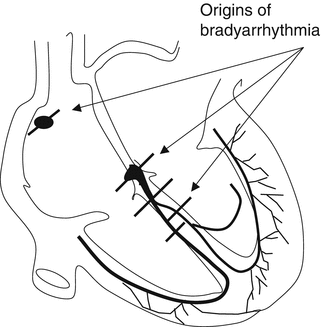(1)
Ospedale Civile di Vigevano, Vigevano, Italy
Arrhythmias are cardiac rhythm abnormalities, that is, rhythms differing from the normal sinus rhythm, which is characterized by heart rates ranging from 60 to 100 beats per minute (bpm). When the rate falls below 60 bpm, the patient is said to have a bradyarrhythmia, whereas rates above 100 bpm are referred to as tachyarrhythmias. Electrocardiographic analysis of an arrhythmia is not limited, however, to heart rate (increased versus decreased): it also includes the rhythm (which can be regular or irregular), the origin (supraventricular versus ventricular), and the morphology of the QRS complex (narrow versus wide) (Table 4.1).
Table 4.1
Criteria for ECG assessment of arrhythmias
Heart rate (bradyarrhythmias: rate <60 bpm; tachyarrhythmias: rate >100 bpm) |
Rhythm (regular or irregular) |
Origin (supraventricular vs. ventricular) |
QRS-complex morphology (narrow: supraventricular origin; wide: supraventricular origin associated with bundle-branch block or ventricular origin) |
Arrhythmias can be caused by any of the following:
1.
abnormal impulse formation;
2.
abnormal impulse conduction;
3.
both of the above mechanisms.
Bradyarrhythmias are the result of delayed or absent formation and/or conduction of the impulse at any level of the conduction system (Fig. 4.1).


Fig. 4.1
Bradyarrhythmias can be the result of delayed/absent formation or conduction of the impulse at the level of the SA node, the AV node, the bundle of His, or the bundle branches
Three electrophysiological mechanisms give rise to tachyarrhythmias: abnormal automaticity, the reentry phenomenon, and triggered activity.
The first involves increased spontaneous firing by pacemaker cells or common cardiomyocytes. It can be caused by various factors, including increased sympathetic activity, ischemia, acidosis, and hypokalemia. These conditions are characterized by increases in the slope of phase 4 of the action potential and in the firing rate of the cardiac cells (Fig. 4.2).




